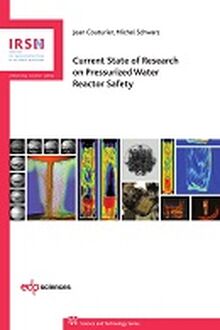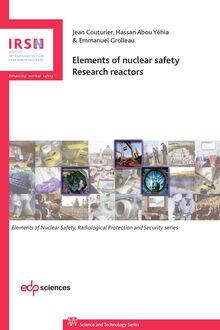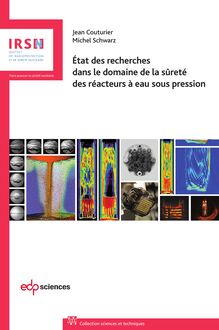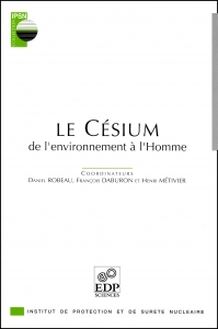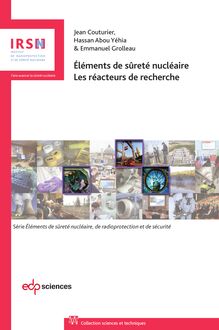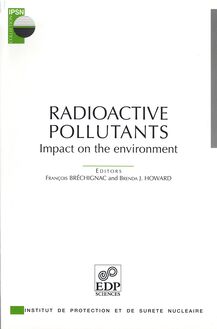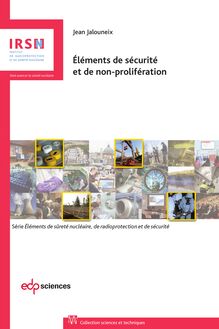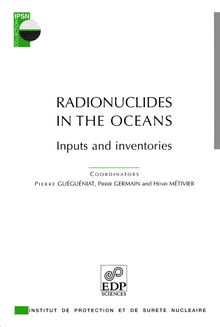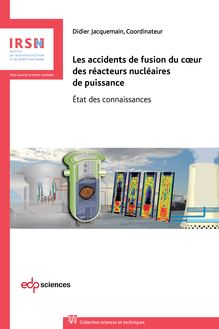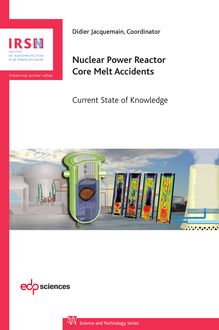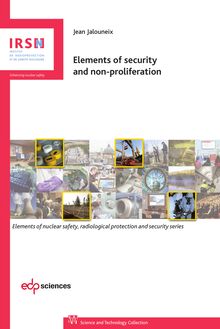Nuclear Power Reactor Core Melt Accidents , livre ebook
434
pages
English
Ebooks
2015
Obtenez un accès à la bibliothèque pour le consulter en ligne En savoir plus
Découvre YouScribe en t'inscrivant gratuitement
Découvre YouScribe en t'inscrivant gratuitement
434
pages
English
Ebooks
2015
Obtenez un accès à la bibliothèque pour le consulter en ligne En savoir plus
Publié par
Date de parution
17 novembre 2015
Nombre de lectures
1
EAN13
9782759819300
Langue
English
Poids de l'ouvrage
8 Mo
For over thirty years, IPSN and subsequently IRSN has played a major international role in the fi eld of nuclear power reactor core melt accidents through the undertaking of important experimental programmes (the most signifi cant being the Phébus- FP programme), the development of validated simulation tools (the ASTEC code that is today the leading European tool for modelling severe accidents), and the coordination of the SARNET (Severe Accident Research NETwork) international network of excellence. These accidents are described as «severe accidents» because they can lead to radioactive releases outside the plant concerned, with serious consequences for the general public and for the environment.
This book compiles the sum of the knowledge acquired on this subject and summarises the lessons that have been learnt from severe accidents around the world for the prevention and reduction of the consequences of such accidents, without addressing those from the Fukushima accident, where knowledge of events
is still evolving.
The knowledge accumulated by the Institute on these subjects enabled it to play an active role in informing public authorities, the media and the public when this accident occurred, and continues to do so to this day.
The Institute for Radiological Protection and Nuclear Safety (IRSN) is a public body undertaking research and consultancy activities in the field of nuclear safety and radiation protection. It provides the public authorities with technical support. It also carries out various public service missions entrusted to it under national regulations. In particular, these include radiological monitoring of French territory and of workers, management of emergency situations, and provision of information to the public. IRSN expertise is available to partners and customers both in France and abroad.
Publié par
Date de parution
17 novembre 2015
Nombre de lectures
1
EAN13
9782759819300
Langue
English
Poids de l'ouvrage
8 Mo
Didier Jacquemain, Coordinator
Nuclear Power Reactor
Core Melt Accidents
Enhancing nuclear safety
Current State of Knowledge
Science and Technology SeriesNuclear Power Reactor Core
Melt Accidents
Current State of Knowledge
Ahmed Bentaïb, Hervé Bonneville, Gérard Cénérino,
Bernard Clément, François Corenwinder, Michel Cranga,
Gérard Ducros, Florian Fichot, Didier Jacquemain,
Christophe Journeau, Vincent Koundy, Denis Leteinturier,
Daniel Magallon, Renaud Meignen, Frédérique Monroig,
Georges Nahas, Frédérique Pichereau, Emmanuel Raimond,
Jean-Marie Seiler, Bruno Tourniaire, Jean-Pierre Van-Dorsselaere
Didier Jacquemain, CoordinatorCover illustration: Radiographic image of Phebus FP test devices and an artist’s impression
of the TMI-2 reactor core after fuel melt.
Printed in France
ISBN: 978-2-7598-1835-8
All rights reserved for all countries. This document may not be translated, adapted or
reproduced by any means without permission. Pursuant to paragraphs 2 and 3 of
Article 41 of the Act of 11 March 1957 only “copies or reproductions strictly reserved for
the copyist’s private use and not intended for collective use” are authorised.
Regarding analyses and brief quotations intended as examples and illustrations, paragraph 1 of
Article 40 of the same Act stipulates that “any representation, in whole or in part, made
without the consent of the author or his/her successors or assignees is illicit.” Such
representation or reproduction, made by whatever means, therefore constitutes an
infringement punishable under Articles 425 et seq. of the French Penal Code.
© IRSN 2015Preface
This new publication on what are referred to as “severe” core melt accidents, which
may occur in pressurised light-water reactors, is the result of one of the most
comprehensive surveys ever conducted on this subject. The knowledge it contains is presented
with a strong educational focus. I would like to take this opportunity to thank all those
mentioned in the foreword who contributed to this vast project, with a special mention
for its coordinator D. Jacquemain.
Although the project was not yet completed, considerable headway had already been
made when the Fukushima Daiichi disaster struck. This was the world’s third severe
accident and resulted in the destruction of three nuclear power reactors and the release of
large quantities of radioactive material to the sea and atmosphere. It raised the question
as to whether the project should be postponed to take into account feedback from these
major events. It was however decided to complete the book as soon as possible as it would
be several years before any detailed scientifc information from the Fukushima Daiichi
accident became available. Furthermore, the knowledge and models already available
within IRSN on the phenomenology of this type of accident had enabled the Institute to
carry out valuable real-time assessments of changes in the state of the reactors.
For more than thirty years, IRSN has been carrying out experimental studies on the
phenomena that lead to reactor core melt and those induced by this type of event.
Back in the 1960s when the frst nuclear power reactors were designed, a core melt
was considered impossible because of the design measures taken to prevent it, such as
design margins and redundant safety systems to halt the chain reaction and remove the
heat generated in the reactor core. Consequently, no measures were included in reactor
design to mitigate the impact of this type of event. This approach had to be rethought
following the accident at the Three Mile Island nuclear power plant in the United States
in 1979. It was then necessary to determine how fuel could be damaged in a reactor core
and, more especially to understand the melting process induced by a loss of cooling that IV Nuclear Power Reactor Core Melt Accidents
could ultimately lead to failure of the reactor coolant system – and the reactor vessel in
particular. The next step was to grasp how chemical or radiolytic reactions could induce
a signifcant release of hydrogen and many fssion products exhibiting varying degrees
of volatility and toxicity.
An experimental programme unlike any other in the world was then launched using
Phebus, a reactor built by the CEA at Cadarache in the south of France. As part of the
programme, fuel melt tests were performed on a reduced scale, representative of the actual
operating conditions in a pressurised water reactor. New knowledge was to emerge from
this impressive programme, including some surprises that called into question certain
theoretical predictions. Models aimed at simulating these extreme phenomena in a
fullscale reactor were then developed and incorporated in computer tools and validated
during these tests.
As knowledge of severe accidents grew over the years, some countries took concrete
steps to improve the safety of power reactors – whether existing or planned.
SARNET, an international network of experts and researchers led by IRSN from
2004 to 2013, coordinated continuous improvement of knowledge and the standards
of models used to simulate severe accident phenomena in various types of reactor. This
collaboration is being continued as part of the European NUGENIA association.
Further experiments are needed, however, to reduce uncertainty on various phenomena
with a signifcant impact on the consequences (especially for health) of a severe
accident, although, based on data from the Phebus programme, such experiments are now
designed as analytical tests, known as separate-effect tests. These are designed to
target individual phenomena for which greater knowledge is required: what happens if an
attempt is made to “refood” a severely damaged, partially melted reactor core? What
happens to the corium – the chemically and thermally aggressive mixture of fuel and
molten metal – once it is released from the reactor core? Another question, of prime
importance for radiation protection, concerns the behaviour of the different chemical
species of radioactive iodine and ruthenium which are produced in large quantities inside
the reactor containment, with varying degrees of volatility.
IRSN and its national and international research partners will continue to devote
considerable resources in these areas over the coming years. For the past ffteen years,
the Institute has never lost sight of the fact that severe accident research is vital.
Unfortunately, the accident at Fukushima proved it right. The knowledge already acquired,
as well as that yet to come, should be used not only to go on improving existing
reactors wherever possible, but also to ensure that in the future, the nuclear industry at
last develops reactors that no longer expose countries opting for nuclear energy to the
risk of accidents, and the ensuing radioactive contamination of potentially large areas,
that most human societies consider unacceptable. I hope that this publication helps to
disseminate existing knowledge on this crucial topic as the new generation of nuclear
engineers takes over from the old. I also hope it serves to illustrate how important it is
to continue research and industrial innovation, without which no essential progress can
be made in the feld of nuclear safety.
Jacques Repussard
IRSN Director-GeneralList of abbreviations
Institutions
AEAT: Atomic Energy Authority Technology, UK (AEC Technology plc)
AECL: Atomic Energy of Canada Limited, a nuclear science and technology research
institute
AEKI: Atomic Energy Research Institute, Budapest, Hungary
ANCCLI: Association nationale des comités et commissions locales d’information (French
National Association of Local Information Commissions and Committees)
ANL: Argonne National Laboratory, USA
ANR: Agence nationale de la recherche (National Research Agency, France)
ASN: Autorité de sûreté nucléaire (Nuclear Safety Authority, France)
AVN: Association Vinçotte nucléaire (Vinçotte Nuclear Association, Belgium)
BARC: Bhabha Atomic Research Centre, India
BNL: Brookhaven National Laboratory, USA
CEA: Commissariat à l’énergie atomique et aux énergies alternatives (Alternative Energies
and Atomic Energy Commission, France)
CLI: Commission locale d’information (French Local Information Commission)
CNL (formerly AECL): Canadian Nuclear Laboratoires
CNRS: Centre national de la recherche scientifque (French National Centre for Scientifc
Research)
CSNI: Committee on the Safety of Nuclear Installations, OECD
EDF: Électricité de France (French power utility)
EPRI: Electric Power Research Institute, USA
FAI: Fauske & Associates, Inc., USAVI Nuclear Power Reactor Core Melt Accidents
FzD: Forschungszentrum Dresden-Rossendorf (research laboratory in Dresden, Germany)
FzK: Forschungszentrum Karlsruhe (Karlsruhe Institute of Technology, Germany)
GRS: Gesellschaft für Anlagen – und Reaktorsicherheit, (reactor safety organisation in
Germany)
IAEA: International Atomic Energy Agency, Vienna, Austria
IAE-NNC-RK: Institute of Atomic Energy – National Nuclear Centre – Republic of
Kazakhstan
IBRAE: Nuclear Safety Institute of Russian Academy of Sciences
ICRP: International Commission on Radiological Protection
IKE: Institut für Kernenergetik und Energiesysteme, Universität Stuttgart (Institute for
Nuclear Technology and Energy Systems, University of Stuttgart, Germany)
INEL: Idaho National Engineering Laboratories, Idaho, USA
INL: Idaho National Laboratory, USA
INSA: Institut national des sciences appliquées (National Institute of Applied Science,
France)
IPSN: Institut de protection et de sûreté nucléaire (Institute for Nuclear Safety and
Protection, France)
IREX: Institut pour la recherche appliquée et l’expérimentation en génie civil (Institute for
Applied Research and Experimentation in Civil Engineering, France)
IRSN: Institut de radioprotection et de sûreté nucléaire (Institute for Radiological
Protection and Nuclear Safety, France)
ISS: Innovative Systems Software, USA
